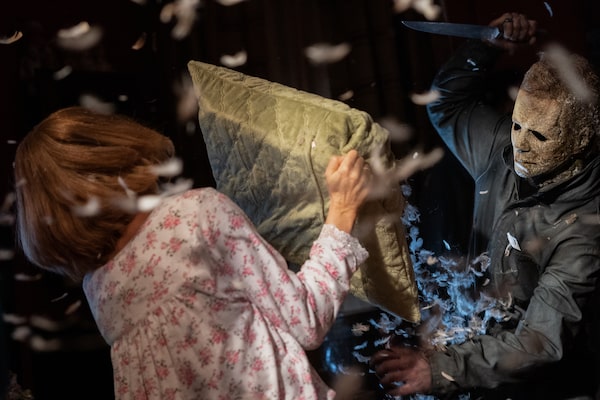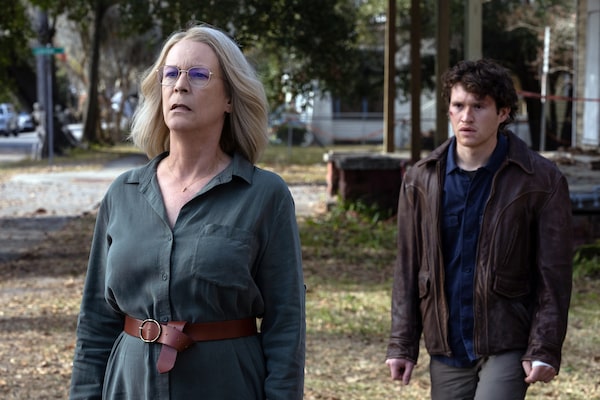
Laurie Strode (Jamie Lee Curtis) and Michael Myers (James Jude Courtney) in Halloween Ends, co-written, produced and directed by David Gordon Green.Ryan Green/Universal Pictures
- Halloween Ends
- Directed by David Gordon Green
- Written by Paul Brad Logan, Chris Bernier, Danny McBride and David Gordon Green
- Starring Jamie Lee Curtis, Andi Matichak and Will Patton
- Classification R; 111 minutes
- Opens in theatres Oct. 14
When asked about the new slasher flick Halloween Ends in an interview with SyFy this summer, legendary horror director John Carpenter was customarily blunt and playful in his answer: “Well, it’s Halloween, and it ends.” With its consistent box office numbers, it’s unlikely that the Halloween franchise will ever truly be finished frightening audiences, but Halloween Ends – the final installment in David Gordon Green’s Halloween trilogy, which more or less reboots Carpenter’s original 1978 film – is more than happy to finally put an end to Michael Myers’ decades-long reign of terror over Haddonfield, Ill. For now.
With Green’s 2018 reboot of Halloween, the writer-director ushered in a new era for the creaky franchise, one that declared it was no longer enough just to play with the series’ regular bag of tricks. The word du jour here was “trauma,” and we were reminded of it at every turn. In a timeline that picked up 40 years after Carpenter’s film, we were met with the image of Laurie Strode (Jamie Lee Curtis) as a survivor above all else. Was it on the nose? Yes. But it gave audiences a chance to reunite with one of the horror genre’s favourite Final Girls – even if Curtis’s long-endeared character had to be endowed with a weighty psychological back story in order to kick butt onscreen.
Green’s second entry, 2021′s Halloween Kills (which picks up on the events of the same night of its predecessor), was even more heavy-handed, reaching a peak of shapeless metaphors on pandemic-era social relations in its far-too-often repeated refrain of, “Evil dies tonight!” Where 2018′s Halloween at least attempted to evoke elements of what made the original Carpenter film so enjoyable, Halloween Kills was a hodgepodge of horrible dialogue and so-called social commentary that felt almost AI-generated from breaking-news headlines.
So Halloween Ends truly had nowhere else to go but up. And thankfully, Green tightens the reigns on his almost compulsive need to phone home a thematic point.
Four years after the horrific night of the first two films, Halloween Ends opens with Laurie having chosen peace. She refuses to live in fear, trading in her kill rooms for attempts at the domestic. She’s writing her memoir, baking pies, and even flirting in line at the grocery store checkout. It is reiterated to us many times that this freedom is a choice, a paradigm-shifting change of Laurie’s own thinking and feeling.
There are nods to the death of her daughter (played in the first two films by Judy Greer), as she and her granddaughter Allyson (Andi Matichak) now live together in quiet turmoil. There is misplaced blame from the people of Haddonfield, who (for some reason, 40 years on) continue to ostracize Laurie despite her attempts at normalcy. It is an othering that leads her to sympathize with the young Corey Cunningham (Rohan Campbell), who accidentally killed a boy he was hired to babysit.
It is a tragedy born of Green’s newest thematic obsession: infection. The mob mentality and groupthink of Halloween Kills are replaced here by a more focused return to the director’s initial survivor narrative, marked by a repeated invocation of Haddonfield’s need for healing. Laurie tells us that the town is gripped by “a plague of grief and panic,” as its people navigate their world with a fear and anxiety governed by the omnipresent spectre of unkillable bogeyman Michael Myers. For Green, to be acting out of terror is to be toeing the line with evil itself.

Charged with wrapping up his bloated trilogy, director David Gordon Green’s latest film is relatively constrained.Ryan Green/Universal Pictures
Charged with wrapping up his bloated trilogy, Green’s latest film is relatively constrained. While suffering from the same lack of internal logic (character motivations are as random as ever) and obvious tonal choices as its predecessor, Green is at least limited in his predisposition toward free-wheeling, overly self-pronounced thematics by the simple fact that he must also close out his chapter of the franchise. With Halloween Ends, there are more nods and homages to Carpenter’s original film – from its kills to its visual style to its inherent questions of morality – all of which ground us within a world that feels like a more concretely faithful extension of its source material.
It wouldn’t be a Green Halloween movie if it wasn’t still overwrought and strangely confounding in its narrative decision-making – but Halloween Ends is at least a more welcome return to what a Halloween film should both look and feel like. The movie calls back to questions of fate and destiny that have marked the franchise as a whole – of knowing the feeling of evil when you see it (or when it sees you).
From the positioning of Corey as its own confused (in more ways than one) Myers progeny to its continued emphasis on Haddonfield’s collective and intergenerational trauma, Halloween Ends smugly reminds us that, “Evil doesn’t die – it changes shape.” And while audiences will surely continue to show up to get a glimpse of the newest Myers tale regardless of its own inherent successes, I hope – for the sake of Halloween fans everywhere – that the inevitable next iteration of the franchise truly lives up to that sentiment.